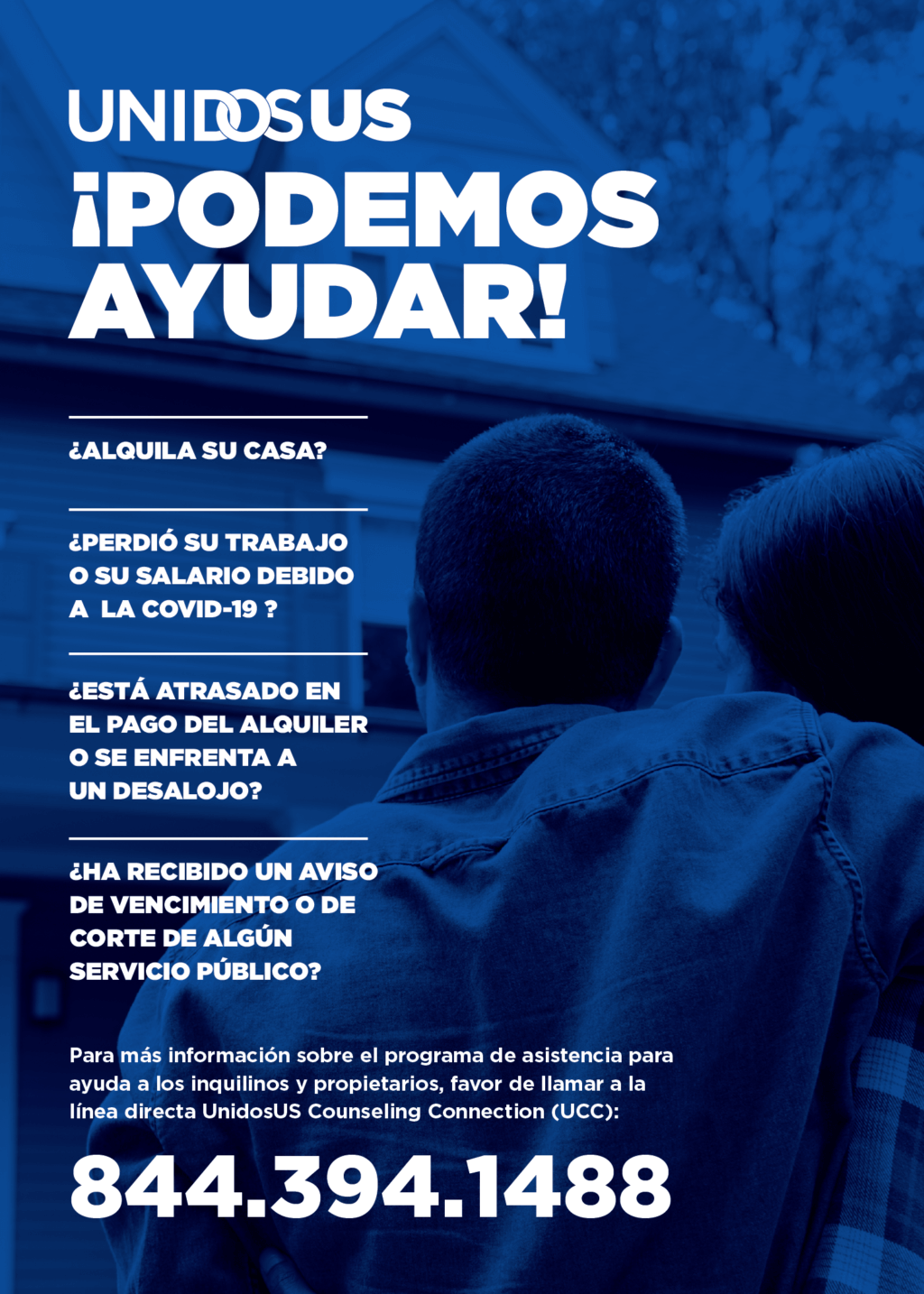Expedited Emergency Rental Assistance program offers a lifeline to Latino renters. The Treasury Dept. has to make sure they receive it.
More than 50% of Latino households rent their homes, placing them in perilous housing situations during the ongoing COVID-19 pandemic. That is why UnidosUS applauds the Treasury Department’s new policies to expedite emergency rental assistance to families in need.
According to the U.S. Census Bureau’s latest Household Pulse Survey, approximately 1.2 million households are very likely to face eviction over the next two months for non-payment of rent. And 29% of them—approximately 348,000 households—are Latino.
Experts at Surgo Ventures, an action tank working on health and social issues, shared with UnidosUS that “Hispanic households are between 20% and 66% more likely to be behind on rent than [W]hite households nationally, even after accounting for socioeconomic status, living situation, and state of residence.”
Keep up with the latest from UnidosUS
Sign up for the weekly UnidosUS Action Network newsletter delivered every Thursday.
Congress has provided rental assistance, but it has been slow to get to renters. The federal government’s pandemic relief packages directed $25 billion—an unprecedented level of funding—to state and local governments through the Emergency Rental Assistance (ERA) Program. Despite this eye-popping amount, just $7.48 billion has been disbursed as of September. To avoid yet another national crisis, state and local governments need to get the remaining $17.52 billion into the hands of high-need families and households.

TREASURY DEPARTMENT URGES STATE & LOCAL PROGRAMS TO EXPEDITE ERA FUNDS
On August 25, the Treasury Department announced seven new policies to accelerate this process. These policies, many of which reaffirm or expand existing Treasury guidance, encourage state and local governments to create flexible and fast-moving ERA programs, and will provide greater access for Latino families.
Since the establishment of the ERA fund, the Treasury Department has permitted “self-attestation,” which allows a renter to attest to facts needed for an application instead of requiring documentation. Despite this provision, more than 40% of states’ ERA programs do not allow any self-attestation. In addition, only 43.4% of all programs (some states have multiple programs) allow applicants to self-attest to financial hardship due to the COVID-19 pandemic. To address this, the Treasury’s new guidance reiterates that households can self-attest their ERA eligibility and clarifies that this extends to household income eligibility when they do not have access to documentation.
Tenants waiting for aid have been hampered by many landlords’ hesitancy to accept ERA funds. Some report that their landlords refuse to accept ERA funds to cover rental arrears—past rent owed by the tenant. In general, landlords want to avoid the bureaucracy and commitment related to rental aid and reaffirm their perceived right to evict and ensure uninterrupted revenue. Many are also reluctant to accept funds that do not cover a tenant’s entire debt or don’t want to have “hard-to-house” tenants—those who would not typically meet occupancy policies due to unemployment or a history of late payments.
In response, the Treasury’s new policies establish that state and local grantees of ERA funds may advance payment to landlords and utility providers based on estimated eligible arrears—any ERA-eligible housing payments that applicants foresee not being able to make. They also enable grantees to give landlords additional rent payments to take on “hard-to-house” households. These policies pave the way for households to access new housing by ensuring they are not unfairly labeled a “hard-to-house” tenant.
Another new policy states that ERA funds can be used to cover past due rental and utility expenses at previous addresses. They can also be used to cover tenants’ costs from obtaining a hearing or appealing an eviction order. This includes rent bonds, financial protection that tenants can provide to landlords in case of a lease agreement breach or to cover costs that they’re liable for at the end of tenancy.
Further, the Treasury’s new policies encourage state and local grantees to work with non-profit organizations to support at-risk households as their applications are processed. Taken as a whole, these policies are a crucial step to ensuring Treasury ERA programs have the capacity and flexibility to expedite emergency rental assistance to all struggling renters.

MORE IS NEEDED
While these are positive steps, the Treasury can do more to further accessibility for Latinos.
First, it should encourage deeper participation by landlords in the ERA program. A survey conducted by the Housing Initiative at Penn, the NYU Furman Center, and the NLIHC found that, in 2020, nearly 50% of ERA programs identified landlord participation as a barrier to disbursing funds. Where landlords are resistant, the Treasury should encourage state and local programs to maximize direct-to-tenant payments—a feature currently used by only 28.3% of all programs.
As many Treasury-funded programs transition to ERA2 funds, the Treasury needs to reiterate its May 2021 guidance that ERA2 programs must provide direct-to-tenant assistance when a landlord refuses to participate. This requirement ensures that tenants receive aid regardless of landlord participation, which diminishes barriers for Latinos struggling to receive federal aid.
We also encourage the Treasury to issue new guidance on disseminating culturally and linguistically appropriate resources, including Spanish-language applications and materials. These materials would help Latinos with language barriers, for whom the application process has become inaccessible due to rigid and technical eligibility requirements imposed by many state and local grantees.
Additionally, we ask the Treasury to create a working presumption, for the duration of the ERA program, that every low- and moderate- income household is experiencing financial hardship attributable to the COVID-19 pandemic. The Treasury used a similar presumption for the Coronavirus State and Local Fiscal Recovery Funds. An August analysis by the Aspen Institute concluded that the economic recession caused by the COVID-19 pandemic magnified and accelerated the existing housing crisis, especially for people of color. Still, programs expect low- and moderate-income renters in need of aid to submit paperwork, navigate intricate application processes, and provide proof of financial hardship because of the COVID-19 pandemic. If the Treasury permitted applicants to assert that fact, it would expedite the application process, saving time and lowering barriers for applicants.
Finally, we urge the Treasury to continue studying barriers to access and reporting their findings publicly.
With millions of Americans still struggling to recover from the economic recession, the pandemic, natural disasters, and the end of many social safety nets such as the extension of federal unemployment insurance (UI), it is more vital than ever to ensure that federal aid is efficiently and equitably distributed to the families that need it most. The millions of Latinos facing eviction right now rely on access to ERA funds for economic progress. The Biden administration and the Treasury Department have provided excellent guidance to expedite ERA funds. We urge them to continue implementing new policies to help Latinos across the country.


